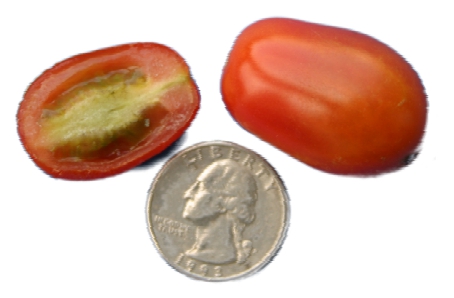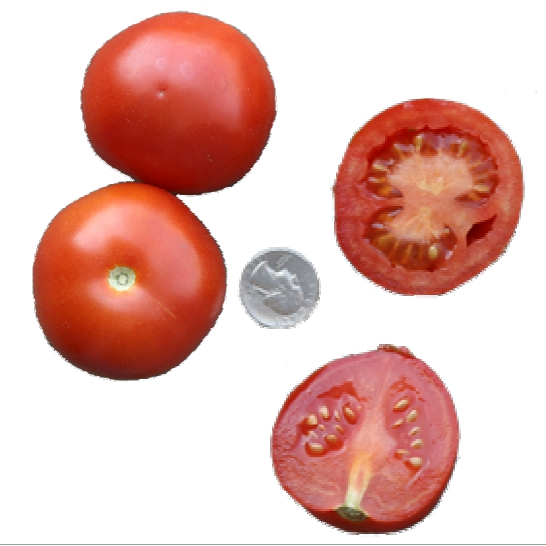I gave a talk to a group of gardeners last year about vegetable and community gardening. There was a wide variety of gardening experience represented, but one statement from a seasoned gardener bothered me a bit. And I think my response bothered him a bit too. I haven’t thought much about it until recently, when a high school English teacher I know told me a student expressed similar ideas in her class. The erroneous idea from my audience member was this: our tomatoes are being poisoned with ‘germetically modinified’…something something. The arguments have lost me beyond that (because there aren’t any). And really, there hasn’t been much talk about sex on this blog recently, so that should be remedied too. Therefore, I would like to take the platform offered by the Garden Professors to talk about plant breeding.

Fig. 1: Jaune flammee, which has at least one gene from at least one of its parents that causes the fruit to have very little lycopene.
Conventional” breeding is when a plant breeder selects parents and offspring and tests them for desirable characteristics (traits). It works the same way as breeding works in nature, except that we humans have a goal we’re working toward. Firm, 5-oz, disease-resistant, crack-resistant tomatoes, for example. In nature, the offspring that survive and reproduce the best in a given environment are ‘blindly’ selected and tend to stick around (Darwin, 1859). Male (sperm) cells are transferred to female (egg) cells by a plant breeder, or a bee, or the wind, or a beetle, or a fly or bird or bat or moth (etc.). The sperm and egg fuse to form an embryo, which grows to become what we’d call a plant. In both natural and artificial selection of tomatoes, no non-tomato DNA has been added, and no tomato DNA has been removed. By the classical definition of ‘genetic modification’, there has been none. I suppose this paragraph was only incidentally about sex, and probably a disappointment to some. Sorry.

Fig. 2. Tainan, a tiny heirloom
The confusion of the issue may lie with the Flavr Savr tomato. This was developed (yes, genetically modified) in the mid-90’s to resist softening during ripening. It has a couple bits of manufactured DNA in it to make this possible. The Flavr Savr is no longer grown or sold in the marketplace (that was SO 1990’s), and to my knowledge, no other transgenic tomatoes are either.

Fig. 3. Rutgers, historically much-cultivated and like all other tomatoes we can buy, bred conventionally.
Confusion may also lie with the plant hormone ethylene. Ethylene is made from incomplete combustion of fossil fuels, but it’s also made by plants. Keep your bananas away from your carnations, right? Bananas make ethylene gas, which causes carnations and snapdragons to senesce (die). Tomatoes make ethylene as they ripen. If you harvest tomatoes a bit early, but not too early, they are hard enough to ship but will still turn red later. If you expose these pre-ripened tomatoes to ethylene gas, they will ripen more quickly and uniformly. That’s what happens to a lot of the tomatoes in our stores. They are not genetically modified, they are treated with a plant hormone. That’s not unusual at all. Ethylene is used to ripen bananas, and to help make cucumber seeds (by eliminating male flowers from female parents). It’s used in growing ornamental plants quite a bit too (but not as much as many other hormones, and especially hormone inhibitors).
So please, if you are someone who tells anybody who will listen that the tomatoes in the store are GMOs, stop it. They’re not.
Maybe GMO tomatos are not available in the stores, but they are being developed. I remember an article about a GMO-Tomato with higher contents of folic acid for instance. I’m quite sure, they’re not developing these tomatos just for the fun of it 😉
With heirlooms being so “in” right now, I think people just assume that the hybrids are GMOs. I get this question all the time, it drives me crazy!
It probably doesn’t help that a popular Science Fiction author sets her novels in an alternate reality where mankind was almost killed off by a genetically modified tomato. Maybe some people are confusion that fiction with reality. Wouldn’t be the first time.
Ah, I remember the Flavor-saver. That was a terrible tasting tomato.
Heiner: Sometimes researchers pursue genetic modification to prove a concept, or to find out more about how the plant works, but I can’t argue that such things aren’t currently being developed commercially. But the product must be marketable and profitable, which has been difficult so far.
Shira: Great way of putting it simply! “Hybrid” is not the same as “genetically modified”!
No need to worry about dangerous tomatoes as long as no one destroys that last copy of Puberty Love!
Mass production will always exist and will only advance. On the other hand, more people are returning to the grassroots way of doing things, including growing their own vegetables. I say, MAYBE you should be wary of supermarket produce.